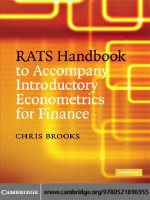cambridge university press a higher dimensional sieve method with procedures for computing sieve functions nov 2008 kho tài liệu bách khoa
Bạn đang xem bản rút gọn của tài liệu. Xem và tải ngay bản đầy đủ của tài liệu tại đây (18.09 MB, 290 trang )
This page intentionally left blank
CAMBRIDGE TRACTS IN MATHEMATICS
General Editors
B. BOLLOBAS, W. FULTON, A. KATOK, F. KIRWAN, P. SARNAK,
B. SIMON, B. TOTARO
177 A Higher-Dimensional Sieve Method
A Higher-Dimensional Sieve Method
HAROLD G. DIAMOND
H. HALBERSTAM
With Procedures for Computing Sieve Functions
WILLIAM F. GALWAY
CAMBRIDGE
UNIVERSITY PRESS
CAMBRIDGE UNIVERSITY PRESS
Cambridge, New York, Melbourne, Madrid, Cape Town, Singapore, São Paulo
Cambridge University Press
The Edinburgh Building, Cambridge CB2 8RU, UK
Published in the United States of America by Cambridge University Press, New York
www.cambridge.org
Information on this title: www.cambridge.org/9780521894876
© H. Diamond, H. Halberstam andW. Galway 2008
This publication is in copyright. Subject to statutory exception and to the
provision of relevant collective licensing agreements, no reproduction of any part
may take place without the written permission of Cambridge University Press.
First published in print format 2008
ISBN-13
978-0-511-43731-1
eBook (EBL)
ISBN-13
978-0-521-89487-6
hardback
Cambridge University Press has no responsibility for the persistence or accuracy
of urls for external or third-party internet websites referred to in this publication,
and does not guarantee that any content on such websites is, or will remain,
accurate or appropriate.
Contents
List of Illustrations
List of Tables
Preface
Notation
Part I
Sieves
page xi
xiii
xv
xvii
1
1
Introduction
1.1
The sieve problem
1.2
Some basic hypotheses
1.3
Prime g-tuples
1.4
The n(n) condition
1.5
Notes on Chapter 1
3
3
4
6
8
11
2
Selberg's sieve method
2.1 Improving the Eratosthenes-Legendre sieve
2.2
A new parameter
2.3
Notes on Chapter 2
13
13
14
17
3
Combinatorial foundations
3.1
The fundamental sieve identity
3.2
Efficacy of the Selberg sieve
3.3
Multiplicative structure of modifying functions
3.4
Notation: V, S(A, V, z), and V
3.5
Notes on Chapter 3
19
19
22
25
26
27
4
The
4.1
4.2
4.3
29
29
33
42
Fundamental Lemma
A start: an asymptotic formula for S(A.q, "P, z)
A lower bound for S(Aq, V, z)
Notes on Chapter 4
viii
Contents
5
Selberg's sieve method (continued)
5.1
A lower bound for G?(£, z)
5.2
Asymptotics for G*(£,z)
5.3
The j and a functions
5.4
Prime values of polynomials
5.5
Notes on Chapter 5
43
43
52
56
64
66
6
Combinatorial foundations (continued)
6.1
Statement of the main analytic theorem
6.2
The S(x) functions
6.3
The "linear" case K — 1
6.4
The cases K > 1
6.5
Notes on Chapter 6
67
67
70
71
73
79
7
The
7.1
7.2
7.3
7.4
7.5
81
81
85
88
92
95
8
An application of the linear sieve
8.1
Toward the twin prime conjecture
8.2
Notes on Chapter 8
97
97
102
9
A sieve method for K > 1
9.1
The main theorem and start of the proof
9.2
The S2i and S22 sums
9.3
Bounds on S ±
9.4
Completion of the proof of Theorem 9.1
9.5
Notes on Chapter 9
103
103
107
110
120
122
10
Some applications of Theorem 9.1
10.1 A Mertens-type approximation
10.2 The sieve setup and examples
125
125
129
11
A weighted sieve method
11.1 Introduction and additional conditions
11.2 A set of weights
11.3 Arithmetic interpretation
11.4 A simple estimate
11.5 Products of irreducible polynomials
11.6 Polynomials at prime arguments
11.7 Other weights
11.8 Notes on Chapter 11
135
135
137
140
144
147
149
150
151
case K = 1: the linear sieve
The theorem and first steps
Bounds for V S ± : the set-up
Bounds for V £ * : conclusion
Completion of the proof of Theorem 7.1
Notes on Chapter 7
Contents
Part II
Proof of the Main Analytic Theorem
ix
153
12
Dramatis personae and preliminaries
12.1 P and Q and their adjoints
12.2 Rapidly vanishing functions
12.3 The II and S functions
12.4 Notes on Chapter 12
155
155
158
160
161
13
Strategy and a necessary condition
13.1 Two different sieve situations
13.2 A necessary condition
13.3 A program for determining F and /
163
163
164
166
14
Estimates of aK{u) — jK(u/2)
14.1 Lower bounds on a
14.2 Differential relations
14.3 The adjoint function of j
14.4 Inequalities for 1 — j
14.5 Relations between a' and 1 — a
14.6 The £ function
14.7 An improved upper bound for 1 — j
14.8 Notes on Chapter 14
169
169
173
177
178
183
184
190
190
15
The
15.1
15.2
15.3
15.4
15.5
15.6
15.7
pK and qK functions
The p functions
The q functions
Zeros of the q functions
Monotonicity and convexity relations
Some lower bounds for pn
An upper bound for pK
The integrands of ft and 3
193
193
195
196
197
199
201
202
16
The
16.1
16.2
16.3
zeros of I I - 2 and 3
Properties of the II and 3 functions
Solution of some II and S equations
Estimation of II(2.7K)
207
207
209
214
17
The
17.1
17.2
17.3
17.4
parameters aK and f3K
The cases n — 1, 1.5
The cases n = 2, 2.5, 3 , . . .
Proof of Proposition 17.3
Notes on Chapter 17
217
217
220
222
227
18
Properties of FK and fK
18.1 FK and fK —5- 1 at oo
18.2 QK(u) > 0 for u > 0
229
229
229
x
Contents
Appendix 1
Al.l
A1.2
A1.3
A1.4
A1.5
A1.6
A1.7
A1.8
A1.9
A1.10
Bibliography
Index
Procedures for computing sieve functions
DDEs and the Iwaniec inner product
The upper and lower bound sieve functions
Using the Iwaniec inner product
Some features of Mathematica
Computing FK(u) and fK(u)
The function Ein(;z)
Computing the adjoint functions
Computing jK(u)
Computing aK and j3K
Weighted-sieve computations
233
234
235
236
239
240
241
242
250
254
255
259
265
List of Illustrations
6.1
F2(u), f2, and l/a2(u)
14.1
The function £(i)
14.2
The differences I2{t) - £(£) and ^(t) - £(£)
Al.l
FK(u;a,P) and fK(u;a,/3) for two choices of a and (3
A1.2
aK and j3K
A1.3
PK{u\ a, (3) and QK(u; a, (3) for two choices of a and /3
A1.4 pK{u) for two values of K
A1.5
qK(u) for two values of K
A1.6
(Q,q)K for two choices of a and (3
A1.7
Two views of the integrand for computing qK (u)
A1.8
Integrand for computing qR(u) for three values of u/n
A1.9
jK(u)
A1.10 Integrand for computing jK(u), "left-hand" path
A l . l l Integrand for computing jK(u), "right-hand" path
A1.12 Region determined by the constraints of Theorem 11.1
A1.13 Lower bound function for the weighted sieve
XI
79
184
186
236
236
237
238
238
239
245
248
250
251
253
256
257
List of Tables
11.1
11.2
11.3
11.4
11.5
11.6
14.1
15.1
15.2
15.3
16.1
17.1
Al.l
r values for small g
r values for small g and h
r values for small G
r values for small g and k and prime arguments
r values for small G and prime arguments
Values of r r for which r PS AT m i n (5,5fc/r r ,r r )
Values of £, 21ogf, £u and £2
The first few q functions
Values of pK
pK + 1 compared with 2.7K
Bounds on UR(vK)
Values of aK, /3K, and pK + l
Accuracy of approximations to qK(u)
148
148
149
150
150
152
185
196
197
201
213
227
249
Preface
Nearly a hundred years have passed since Viggo Brun invented his famous sieve, and yet the use of sieve methods is still evolving. At one
time it seemed that, as analytic tools improved, the use of sieves would
decline, and only their role as an auxiliary device would survive. However, as probability and combinatorics have penetrated the fabric of
mathematical activity, so have sieve methods become more versatile and
sophisticated, especially in conjunction with other theories and methods, until, in recent years, they have played a part in some spectacular
achievements that herald new directions in mathematical discovery.
An account of all the exciting and diverse applications of sieve ideas,
past and present, has yet to be written. In this monograph our aim
is modest and narrowly focused: we construct (in Chapter 9) a hybrid
of the Selberg [Sel47] and Rosser-Iwaniec [Iwa80] sieve methods to deal
with problems of sieve dimension (or density) that are integers or half
integers. This theory achieves somewhat sharper estimates than either of
its ancestors, the former as given by Ankeny and Onishi [AO65]. The sort
of application we have in mind is to show that a given polynomial with
integer coefficients (some obvious cases excluded) assumes at integers or
at primes infinitely many almost-prime values, that is, values that have
few prime factors relative to the degree of the polynomial. To describe
our procedure a little more precisely, we extend the pioneering method
of Jurkat and Richert [JR65] for dimension 1 (that combined the Selberg
sieve method with infinitely many iterations of the Buchstab identity)
to higher dimensions by means of the Rosser-Iwaniec approach; in the
process we give an alternative account of that approach.
The restriction we make to integer and half integer dimensions simplifies the analytic component of our method; an account avoiding this
xvi
Preface
constraint exists [DHR88]-[DHR96], but is much more complicated. A
justification for our restriction is that most sieve applications of the
above kind occur in this context. We include an account of the case of
dimension 1 because it serves as a model for what is to come and involves
little extra work. While our treatment of that special case is not quite
as sharp as in the classical exposition of Iwaniec [Iwa80] or that given
more recently by Greaves [GrvOl], it is somewhat simpler.
It should be said that our results for higher dimensions, unlike the
case of dimension 1, are almost certainly not best possible, not even in a
single instance; and that our approach might not be the right one there.
Nevertheless, our method does have good applications, is simple to use,
and, despite some complications of detail, rests solely on elementary
combinatorial inequalities and relatively simple analysis. The combinatorics we have developed may in due course find other applications.
The first comprehensive account of sieve methods, by the second
author and H.-E. Richert [HR74], appeared in 1974 and has been long
out of print. Although it is also out of date in some important respects,
we have tended to follow its overall design, and we have drawn on it for
examples and applications.
We are happy to express our thanks to the many who have contributed
to this work: the aforementioned authors, on whose ideas we have built;
H.-E. Richert, who shared in our discoveries; our former students Ferrell
S. Wheeler and David M. Bradley for their extensive computational assistance; our patrons, the University of Illinois and the National Science
Foundation, who supported our research; our colleague A. J. Hildebrand
for IMpjX and mathematical advice; Sidney Graham and Craig Franze
for help in rooting out errors; and Cherri Davison, who skillfully and
cheerfully converted our manuscript into I^TJTJX. Also, we thank our
wives for their support during the preparation of this book.
The Mathematica® < package of sieve-related functions described in
Appendix 1, as well as a list of comments and corrigenda, will be maintained at Finally, we
request that readers advise us of any errors or obscurities they find. Our
e-mail address is sievetheorybookSmath.uiuc.edu.
| Mathematica is a registered trademark of Wolfram Research, Inc.
Notation
Standard terminology
[a;] denotes the largest integer not exceeding x.
a | b means a divides b evenly, i.e., 6 = 0 mod a.
(a, b) denotes the greatest common divisor of the integers a and b
(when no confusion with notation for an open interval is possible) and
{a, b} their least common multiple (see p. 14).
The symbols for the classical arithmetic functions have their usual
meaning: /x(-) is the Moebius function, r(-) the divisor function, </>(•)
Euler's totient function, TT(X) the number of primes not exceeding x,
and TV(X, k, (.) the number of primes not exceeding x and congruent to £
modulo k.
We use !/(•) for the number of distinct prime divisors and f2(-) for the
number of prime divisors counted according to multiplicity. Throughout
Part I of this manuscript, p(-) and p+(-) are the least and largest prime
factors respectively of an integer (see p. 19).
The constants IT and e have their usual meanings, and 7 is always
Euler's constant.
O(-) and o(-) have their usual meanings relating to the size of a function, and Oz{) indicates dependence of the implied constant upon z.
A,B,C,...
denote integer sequences or sets, and |.A|, \B\, \C\,... their
cardinalities; Ad denotes the sequence of multiples of d in A. That is,
Ad •— {a £ A : d \ a} — {a s A : a = 0 mod d}.
V is always a set of primes, the variable p denotes a prime throughout
Part I of this book, and Vc is the set of primes not in V•
N is the sequence of natural numbers, Q the set of rationals.
xviii
Notation
Sieve notation
The following lists indicate where sieve functions and sieve terminology
are introduced and defined:
The notions of a function being divisor closed and/or combinatorial
are defined on p. 27.
Pr denotes an integer having at most r prime factors, counted according to multiplicity; thus n is a Pr if Q(n) < r (see p. 141).
Multiplicative functions
UJ
p. 5
w*
p. 49
9
p. 15
g*
p. 44
P
pp. 37, 39, 64, 125
Remainder terms
rA(d)
p. 5
R
p. 14 (2.5)
RA{Y,z)
p. 109 (9.27)
Summatory functions
G, Ge(P)
p. 15 (2.10)
G(£, z), G(0
pp. 30 (4.2), §5.1, 61 (5.44)
G*(£,z)
p. 44 (5.7), §5.2
G*(£)
pp. 45, 52 (5.22), 54 (5.25)
D(wi,w)
p. 139
£{x,d)
p. 97
Notation
Integrals (and associated expressions)
p. 53
p. 56 (5.28)
T(Z,z)
U{£,z)
p. 58
(G,G)K
pp. 158, 178, 234 (A1.3)
UK(u,v),
EK(u,v)
p. 160 (12.24), (12.25)
n(u),3(u)
p. 161
U(u),E(u)
p. 161
Products
P
p. 3
V(V)
p. 5
P(z)
p. 26
V(z)
p. 26
V*(z)
p. 56
Sifting functions
S(A,V)
S(A,V,i
p- 4
pp . 7, 26
Si(x), S:nix), * = i,2
p. 70, (6.9) (6.10) (6.11)
E(-r
PP . 89, 110 (9.38) , 116 (9.50)
P- 89 (7.14)
P- 106 (9.16)
P- 109 (9.26)
D{-y{x, w,z0)
w(A,r, z,y)
W0{A,V,z,y)
W(A,V, z,y,X)
P- 110
P- 135 (11.1)
P- 135
P- 137 (11.6)
xix
Notation
XX
Transcendental functions
e(w)
*«(•)
U)
p. 50 (5.19)
pp. 56, 68 (6.7) (6.8)
pp. 56 (5.29) (5.30), 250
p. 57 (5.32)
FK{u), fK(u)
pp. 67 Theorem 6.1, 235
p. 84
$i(y), S2{y)
m
pp. 106 (9.19), 108 (9.23)
p. 139
PK(u), QK{u)
p. 155 (12.1)
pK(u)
pp. 157 (12.11), 193 §15.1, 242 §A1.7
QK(u)
pp. 157 (12.16), 195 §15.2, 242 §A1.7
Ein(i)
pp. 157 (12.12) (12.13), 241
rK(u)
p. 177 (14.21)
ip(u)
p. 183
p. 184
Weight functions
w(a), wo(a)
p. 135
Constants/parameters
A
p. 7
K, A
p. 8 Definition 1.3
a K , /3K
p. 67 Theorem 6.1
uK
p. 173 Lemma 14.4
Mo
p. 136 (11.4)
r
p. 136 (11.3)
Ar
p. 142 (11.16) Corollary 11.2
N(U,V;K,UO,T)
pp. 142, 255
PK
p. 196 §15.3
Notation
Basic conditions
n{n)
p. 8, §1.4
O*(K)
p. 44
Qo, -Ro, M"o
p. 136 (11.2) (11.3) (11.4)
"Modifying" functions
P- 13
X(")
P- 19 (3.1)
X(-)
±
±
X (-).'? (-)
xH-),vH-)
(« = 1)
(
K
>1)
p. 71 §6.3 (6.15)-(6.18)
p. 74 §6.4 (6.20)-(6.22)
For cases re > 1, see also
X±(-), r?±(-)
pp. 103-104 (9.5)-(9.7)
^F(d)
p. 104 (9.8)
xxi
Part I
Sieves









